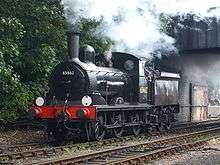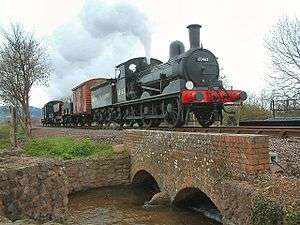GER Class Y14
|
No. 65462 with a demonstration freight train | |||||||||||||||||||||||||||||
| |||||||||||||||||||||||||||||
| |||||||||||||||||||||||||||||
| |||||||||||||||||||||||||||||
| |||||||||||||||||||||||||||||
The Great Eastern Railway (GER) Class Y14 is a class of 0-6-0 steam locomotive. The LNER classified them J15.
The Class Y14 was designed by T.W. Worsdell for both freight and passenger duties - a veritable 'maid of all work'. Introduced in July 1883, they were so successful that all the succeeding chief superintendents continued to build new batches down to 1913 with little design change, the final total being 289.[1] During World War I, 43 of the engines served in France and Belgium.[2]
Background
On 10–11 December 1891, the Great Eastern Railway's Stratford Works built one of these locomotives and had it in steam with a coat of grey primer in 9 hours 47 minutes; this remains a world record. The locomotive then went off to run 36,000 miles (58,000 km) on Peterborough to London coal trains before coming back to the works for the final coat of paint. It lasted 40 years and ran a total of 1,127,750 miles (1,814,940 km).[3]
Because of their light weight the locomotives were given the Route Availability (RA) number 1, indicating that they could work over nearly all routes.
| Year | Order | Manufacturer | Quantity | GER Nos. | LNER Nos. | 1946 Nos. | Notes |
|---|---|---|---|---|---|---|---|
| 1883 | Y14 | Stratford Works | 10 | 610–619 | 7610–7618, — | — | |
| 1884 | K15 | Stratford Works | 20 | 620–639 | 7620–7639 | — | |
| 1884 | — | Sharp, Stewart & Co. 3146–3164 | 19 | 37–41, 119–124, 592–599 | 7037, 07038–07039, —, 7600, 7119–7124, 7592–7599 | — | 41 renumbered 600 in 1912 |
| 1885 | N16 | Stratford Works | 10 | 680–689 | 7680–7689 | — | |
| 1885–86 | P17 | Stratford Works | 10 | 690–699 | 7690–7699 | — | |
| 1886 | M18 | Stratford Works | 10 | 800–809 | 7609, 7801–7809 | — | 800 renumbered 609 in 1892 |
| 1886–87 | X18 | Stratford Works | 10 | 810–819 | 7810–7819 | 5350 | |
| 1887 | D20 | Stratford Works | 10 | 820–829 | 7820–7829 | 5351–5353 | |
| 1887–88 | U20 | Stratford Works | 10 | 527–536 | 7527–7536 | 5354–5356 | |
| 1888 | R21 | Stratford Works | 10 | 537–541, 830–834 | 7537–7541, 7830–7834 | 5357–5360 | |
| 1889 | T22 | Stratford Works | 10 | 835–844 | 7835–7844 | 5361–5364 | |
| 1889 | P23 | Stratford Works | 10 | 845–854 | 7845–7854 | 5365–5372 | |
| 1889 | T23 | Stratford Works | 10 | 855–864 | 7855–7864 | 5373–5375 | |
| 1889 | Y23 | Stratford Works | 10 | 865–874 | 7865–7874 | 5376–5381 | |
| 1890 | U25 | Stratford Works | 10 | 875–884 | 7875–7884 | 5382–5388 | |
| 1890 | Y25 | Stratford Works | 10 | 885–894 | 7885–7894 | 5389–5394 | |
| 1891 | L28 | Stratford Works | 10 | 895–904 | 7895–7904 | 5395–5400 | |
| 1891 | N28 | Stratford Works | 10 | 905–914 | 7905–7914 | 5401–5407 | |
| 1891 | P28 | Stratford Works | 10 | 915–924 | 7915–7924 | 5408–5414 | |
| 1891–92 | S28 | Stratford Works | 10 | 925–934 | 7925–7934 | 5414–5421 | |
| 1892 | X28 | Stratford Works | 10 | 936–945 | 7936–7945 | 5422–5427 | |
| 1899 | I45 | Stratford Works | 10 | 507–516 | 7507–7516 | 5428–5435 | |
| 1899 | S45 | Stratford Works | 10 | 517–526 | 7517–7526 | 5436–5439 | |
| 1899 | X45 | Stratford Works | 10 | 640–649 | 7640–7649 | 5440–5449 | |
| 1906 | A60 | Stratford Works | 10 | 552–561 | 7552–7561 | 5450–5459 | |
| 1912 | B70 | Stratford Works | 10 | 562–571 | 7562–7571 | 5460–5469 | |
| 1913 | G73 | Stratford Works | 10 | 542–551 | 7542–7551 | 5470–5479 | |
Accidents and incidents
- On 25 September 1900, a locomotive of the class was involved in a boiler explosion at Westerfield, Suffolk.[5][6]
- On 7 January 1927, locomotive No. 7613 was hauling a freight train that was in collision with a lorry at Roudham Heath, Norfolk, on the Breckland Line due to errors by the crossing keeper. The lorry driver was killed.[7]
- On 4 October 1929, locomotive No. 7938 was hauling a freight train that departed against a danger signal at Tottenham, London and was subsequently stopped foul of a junction. Both crew abandoned the locomotive before an express passenger train was in collision with it.[8]
Notable features
As built all the locomotives had a stovepipe chimney; this was replaced in LNER days by a cast chimney with a small lip. The original Worsdell and early Holden series had three-ring boilers with the steam dome placed in the middle. Also the Worsdell boilers had a flat grate, however from 1890 Holden developed a boiler with a sloping grate and a two-ring telescopic barrel with the dome located well forward. The advantage of the dome position was a short 5½ inch steam pipe which limited pressure drop between the boiler and the cylinders. This boiler was adopted as standard and persisted on all Great Eastern Locomotives down to 1898; from then on it was perpetuated on the smaller locomotives as long as these remained essentially in their original configuration - which could be down to the 1960s.[2]
As with all Great Eastern classes, the Y14 had a cab with a low wooden roof covered with canvas sealed by a coat of lead paint. This was replaced in LNER days by a higher arched sheet metal roof. Some engines had special side window cabs for service on the exposed Brightlingsea and Colne Valley branches.[2]
Allocations
On 1 January 1923 there were 272 J15 locomotives in existence. They were allocated as follows:[9]
- Cambridge 48
- Colchester 14
- Ipswich 32
- King's Lynn 5
- Lincoln 3
- Lowestoft 7
- March 17
- Norwich 36
- Parkeston 2
- Peterborough East 19
- Stratford 91
- Yarmouth 4
On 1 January 1948 when British Railways took running the nation's railways, there were 127 J15 locomotives in existence.[10]
Unusually in 1957 a couple of the class were allocated to Aylesbury and worked freight trains on the former Great Western Railway branch from Princes Risborough to Watlington before being withdrawn in 1958.[11]
In fiction
In The Railway Series children's books by Christopher Awdry, a Class J15 appears in the book Toby, Trucks and Trouble nicknamed "The Old Engine" despite the locomotive being younger than Toby.
Preservation

Number 564/7564/65462 is preserved on the North Norfolk Railway and owned by the Midland and Great Northern Joint Railway Society.[12] In 2002 the locomotive reached the end of a major overhaul and was painted in LNER (numbered 7564) and BR black numbered 65462) liveries for the duration of its boiler ticket. It originally operated in these liveries when classified as a J15 in LNER and BR days. Following withdrawal from service in 2013, the locomotive received another overhaul (completed 2015) where it was outshopped in GER lined blue and sporting its original number of 564 and representing its days when classified as a Y14.
Models
Hornby produces a ready-to-run model of the J15 in 00 gauge (4 mm) in BR (with the rebuilt high-arched cab roof) and LNER liveries (both as-built and high-arch cab roofs).[13] Also in 00 gauge, there are kits from Alan Gibson and Nu-Cast. Finley and Smith produce a 3 mm kit.
References
- ↑ Locomotives of the Great Eastern Railway
- 1 2 3 The Class J15 (GER Class Y14) 0-6-0 Locomotives
- ↑ Allen 1961, p. 110.
- ↑ Baxter 2012, pp. 51–52, 67–72.
- ↑ Freestone, Jill; Smith, Richard W (1998). Ipswich Engines and Ipswich Men. Ipswich: Under Stoke History group. ISBN 0-9532257-0-4.
- ↑ http://www.railwaysarchive.co.uk/documents/BoT_Westerfield1900.pdf
- ↑ Lt. Col A H Mount / Board of Trade (7 January 1927). "London and North Eastern Railway" (PDF). Retrieved 10 April 2016.
- ↑ Earnshaw 1990, p. 16.
- ↑ Yeadon, W B (1996). LNER Locomotive Allocations 1st January 1923 (The first day). Challenger Publications. ISBN 1-899624-19-8.
- ↑ "Steam Loco Class Information Class J15 Details". RailUK. Retrieved 8 November 2010.
- ↑ Great Eastern Railway Society Journal No 84 - letter and photograph from Dick Riley (October 1995)
- ↑ Midland and Great Northern Joint Railway Society - Home
- ↑ "National Model Rail Database". National Model Rail. Retrieved 13 September 2015.
- Allen, Cecil J. (1961) [1955]. The Great Eastern Railway. London: Ian Allan.
- Baxter, Bertram (2012). Baxter, David; Mitchell, Peter, eds. British Locomotive Catalogue 1825–1923, Volume 6: Great Eastern Railway, North British Railway, Great North of Scotland Railway, Midland & Great Northern Joint Railway, remaining companies in the LNER group. Southampton: Kestrel Railway Books. ISBN 978-1-905505-26-5.
- Fry, E. V., ed. (September 1966). Locomotives of the L.N.E.R., Part 5: Tender Engines—Classes J1 to J37. Kenilworth: RCTS. ISBN 0-901115-12-6.
- Earnshaw, Alan (1990). Trains in Trouble: Vol. 6. Penryn: Atlantic Books. ISBN 0-906899-37-0.
- Freestone, Jill; Smith, Richard W. (1998). Ipswich Engines and Ipswich Men. Ipswich: Under Stoke History group. ISBN 0-9532257-0-4.
- Yeadon, W. B. (1996). LNER Locomotive Allocations 1st January 1923 (The first day). Challenger Publications. ISBN 1-899624-19-8.
External links
| Wikimedia Commons has media related to GER Class Y14 / LNER Class J15. |
